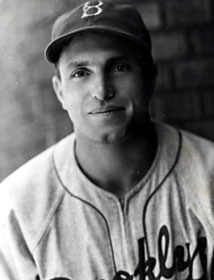In many ways the key year in the Dodgers late 1930s, early 1940s turn around was 1939. It ushered in a series of major changes that led ultimately to the 1941 pennant. So let’s us take a look at the 1939 team.
Arguably the most significant change occurred in the dugout. Manager Burleigh Grimes was terminated at the end of the dismal 1938 campaign by new President and General Manager Larry McPhail. The addition of McPhail was in itself a significant change in Brooklyn’s front office. Grimes’ successor was player-manager Leo Durocher. “Leo the Lip” was loud, abrasive, fiery and hated losing (and I can’t believe I’ve never done anything on him). He brought a fire to the Dodgers that was lacking under Grimes (who could be fiery himself). A number of the players didn’t particularly like Durocher, but he had the respect of most of them. He and McPhail made for a strange and interesting pair leading the franchise.
The infield saw one change. Pete Coscaret went from being the backup to playing the most innings at second, while former starter John Hudson became the primary backup middle infielder. With shortstop Durocher now managing, Hudson saw more action than a backup might normally see (he got into 109 games). Dolph Camilli and Cookie Lavagetto continued to hold down the corners of the infield. Lavagetto hit .300 and was second on the team in home runs (10) and RBIs (87). Camilli led the team in both with 26 home runs and 104 RBIs (his WAR and OPS+ also topped the starters).
The outfield underwent a significant change in 1939. Of the 1938 starters, only Ernie Koy remained a primary outfielder. Gene Moore and Art Parks took over the other positions while Goody Rosen became a backup and Bud Hassett moved to the Braves. Of major significance for 1941, the Dodgers picked up a new backup outfielder when 28-year-old Dixie Walker was picked up on waivers from Detroit. He would, by 1941, become one of the more famous players on the pennant winning team. For 1939 he hit .280 with 83 total bases (0.3 WAR).
Although Babe Phelps remained the primary catcher, the staff he handled added two major pieces to the pennant winning puzzle. Holding on to Luke Hamlin and Fred Fitzsimmons as starters, and moving Tot Presnell from spot starter to a major contributor helped Brooklyn, but the two new guys were key. One was Whit Wyatt. He was 31, had spent several mediocre years in the American League, spent 1938 in the Cleveland minor league system (Milwaukee), and was purchased by Brooklyn for 1939. He went 8-3 in 16 games (14 starts) and made the All-Star game. By 1941 he was the Dodgers’ ace. The other new guy was Hugh Casey. Casey was 25, had a cup of coffee with the Cubs in 1935, and became a full-time player only in 1939 after being picked up by Brooklyn from Memphis. Although known today primarily as a reliever, he started 25 games in 1939 and posted a 15-10 record, a 5.3 WAR, and managed to lead the National League in hit batsmen with 11.
The result of all this was a third place finish and a winning season for the Dodgers; their first in several years. Much of the “Daffiness Boys” syndrome was gone and they were emerging as a legitimate contender in the National League. By this point half the infield was in place, much of the pitching staff was available and the first of the outfield was on board. With Leo Durocher piloting the team, and McPhail ready to make the necessary acquisitions, they were finally moving in the right direction.
As an aside, there was also one other notable addition to the Dodgers, although it didn’t change the play on the field. The 1939 season saw Brooklyn pick up a new play-by-play radio announcer. Red Barber joined the team in the booth in 1939.

